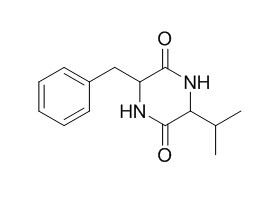Cyclo(Phe-Val)
Cyclo(Phe-Val) is a new cell cycle inhibitor, it shows cyctoxic activity in vitro.
Inquire / Order:
manager@chemfaces.com
Technical Inquiries:
service@chemfaces.com
Tel:
+86-27-84237783
Fax:
+86-27-84254680
Address:
1 Building, No. 83, CheCheng Rd., Wuhan Economic and Technological Development Zone, Wuhan, Hubei 430056, PRC
Providing storage is as stated on the product vial and the vial is kept tightly sealed, the product can be stored for up to
24 months(2-8C).
Wherever possible, you should prepare and use solutions on the same day. However, if you need to make up stock solutions in advance, we recommend that you store the solution as aliquots in tightly sealed vials at -20C. Generally, these will be useable for up to two weeks. Before use, and prior to opening the vial we recommend that you allow your product to equilibrate to room temperature for at least 1 hour.
Need more advice on solubility, usage and handling? Please email to: service@chemfaces.com
The packaging of the product may have turned upside down during transportation, resulting in the natural compounds adhering to the neck or cap of the vial. take the vial out of its packaging and gently shake to let the compounds fall to the bottom of the vial. for liquid products, centrifuge at 200-500 RPM to gather the liquid at the bottom of the vial. try to avoid loss or contamination during handling.
J Ethnopharmacol.2017, 198:205-213
Biomedicine & Pharmacotherapy2020, 125:109950
Life Sci.2022, 311(Pt A):121157.
Natural Product Sciences2024, 30(4):254-261.
Int J Mol Sci.2020, 21(9):3144.
Eur J Pharm Sci.2016, 94:33-45
J Chromatogr B Analyt Technol Biomed Life Sci.2020, 1149:122123.
J. of Med. Plant Research.2013, 90-151
Evid Based Complement Alternat Med.2016, 2016:4357656
Food Funct.2022, doi: 10.1039
Related and Featured Products
Journal of Shenyang Pharmaceutical University, 2007, 24(8):474-8.
Cyclic dipeptide constituents from the mangrove fungus Penicillium oxalicum[Reference:
WebLink]
To study the metabolites of mangrove fungus Penicillium oxalicum from the south China sea and search for new anti-tumor compounds.
METHODS AND RESULTS:
Compounds were isolated by silica gel,ODS column chromatography,Sephadex LH-20 column chromatography and reversed-phase HPLC purification.Structural elucidation was achieved by physico-chemical constants and spectroscopic analysis.MTT assay was used to evaluate the bioactivities in vitro.Six cyclic dipeptides were isolated from the acetone extracts of mycelium of fungus and elucidated as cyclo-(Phe-Ile)(1),Cyclo(Phe-Val)(3),cyclo-(Ile-Leu)(3),cyclo-(Val-Val)(4),cyclo-(Pro-Val)(5),cyclo-(Pro-Gly)(6).Coumpouds 2,3 and 5 could evidently inhibit the growth of cancer cell lines HepG Ⅱ and LNCaP at the concentration of 50 μg·mL-1.
CONCLUSIONS:
All of Compounds are obtained from the marine fungus for the fist time.Compounds 2,3 and 5 show cytotoxic activity in vitro.
Journal of Shenyang Pharmaceutical University, 2015 (2):107 -10.
Cyclic dipeptides as new cell cycle inhibitors produced by Streptomyces flavoretus 18522[Reference:
WebLink]
To find the cell cycle inhibitors from the metabolites of Streptomyces flavoretus 18522.
METHODS AND RESULTS:
Activity-guided isolation was performed on the chloroform extract of the fermentation broth and mycelia of Streptomyces flavoretus 18522 by using ts FT210 cells.Compounds were isolated through various chromatoghraphic methods and elucidated by spectroscopic means.The flow cytometry was used to evaluate the cell cycle inhibiting activity of the fractions and compounds. Six cyclic dipeptides were obtained and identified as cyclo(Ala-Leu)(1),cyclo(Ala-Ile)(2),cyclo(Ala-Val)(3),cyclo(Phe-Leu)(4),cyclo(Ala-Pro)(5) and Cyclo(Phe-Val)(6).
CONCLUSIONS:
Compounds 1-6 are reported as new cell cycle inhibitors for the first time.
Evidence-Based Complementary and Alternative Medicine Volume 2011 (2011), Article ID 393752, 6 pages
Description of a Sulfitobacter Strain and Its Extracellular Cyclodipeptides[Reference:
WebLink]
A marine bacterium M44 was separated from 30 m deep seawater in the East China Sea (26° 28.3′ N 122° 29.0′ E) in 2006. 16S rDNA gene sequence comparison showed that the strain M44 was a member of the genus Sulfitobacter and highly similar to KMM 3554T. A series of experiments demonstrated that this strain M44 had many distinctive characteristics: its cells were gram-negative and mesophilic; its colonies were slightly yellowish, round, convex, and smooth; and it could grow at 10–28°C, pH 6.0–10.0, and in the presence of 0–12.5% (w/v) NaCl; the optimum growth conditions were 25°C and pH 7.0, and the optimum Na+ concentration was 2.5%. In addition, strain M44 contained 18 : 1 ω7c, 11 methyl 18 : 1 ω7c and 16 : 0 fatty acids as major fatty acids, and the genomic DNA G+C content was 58.04 mol%.
METHODS AND RESULTS:
According to our results of the secondary metabolites, six cyclodipeptides were isolated from the strain M44, which were Cyclo (Val-Leu), Cyclo(Phe-Val), Cyclo (Phe-Leu), Cyclo (Leu-Ile), Cyclo (Phe-Ile), and Cyclo (Trp-Pro).
CONCLUSIONS:
It is the first study of secondary metabolites isolated from this genus.



